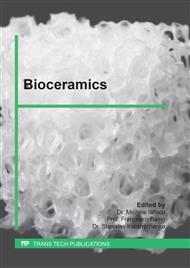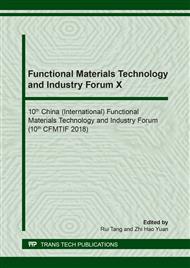[1]
S.P. Li: Introduction to Biomedical Materials [M](Wuhan: Wuhan University of Technology Press, China 2000).
Google Scholar
[2]
S.M. Song: Physical Chemistry [M](Beijing: Higher Education Press, China 1993).
Google Scholar
[3]
A.Q. Zhang, M. Lu, Y.H. Xiao, et al. Preparation and bio-mineralization of TiO2 nanotubes on the surface of Ti-Al alloy [J]. Plating and Finishing, Vol. 35 (2013) No.3, p.28.
Google Scholar
[4]
L.Zeng: Preparation and bioactivities of FHA and BG-BG-FHA composite coating [D](MS.,Central South University, China 2010).
Google Scholar
[5]
C.B. Xue:Study on the bioactivity and adsorption functions of modified nano-hydroxyapatite [D] (MS.,Yangzhou University,China 2016).
Google Scholar
[6]
Y.L. Lv, B. Yin, M. Xia, et al. Sr-containing bioglass fabricated by sol-gel method and its solubility [J]. Materials Science and Engineering of Powder Metallurgy, Vol.20(2015) No.2, p.296.
Google Scholar
[7]
H.H. Chai, Z.Y. Huang, H.P. Yu, et al. Preparation and bioactivity of HA-SrCO3-SiO2 composite coating [J]. Journal of Composite Materials, Vol.33(2016) No.4,p.859.
Google Scholar
[8]
J.H. Ge, Y.P. Lu, M.S. Li, et al. Degradation and biomineralization properties of PLGA tissue engineering scaffold in SBF [J]. Journal of Materials Science and Engineering, Vol.28(2010) No.5,p.684.
Google Scholar
[9]
X.H. Xu:Preparation, characterization and properties of co-substituted nano hydroxyapatite [D]( MS.,Tianjin University, China 2016).
Google Scholar
[10]
S. Mei: Biomineralization of pure titanium implant surface and its effect on osseointegration [D]( Ph.D.,Hebei Medical University,China 2016).
Google Scholar
[11]
N.R. Yang: Testing methods for inorganic nonmetallic materials [M](Wuhan: Wuhan University Press, China 1990).
Google Scholar
[12]
Q.X. Zhu, Q.Q. Xu, M.H. Luo. Biomeralization behavior of carbonated hydroxyapatite [J]. Journal of Ceramics, Vol. 31(2010) No. 2, p.234.
Google Scholar
[13]
R. Tang, Z.J. Henneman, and G.H. Nancollas. Constant composition kinetics study of carbonated apatite dissolution[J]. Journal of Crystal Growth, Vol. 249 (2003), p.614.
DOI: 10.1016/s0022-0248(02)02332-1
Google Scholar
[14]
A. Ito, K. Maekawa and S. Tsutsumi. Solubility product of OH-carbonated hydroxyapatite[J]. J Biomed Mater Res.. Vol. 36 (1997), p.522.
DOI: 10.1002/(sici)1097-4636(19970915)36:4<522::aid-jbm10>3.0.co;2-c
Google Scholar
[15]
Y. Wang, J.C. Gao, Y.P. Zhang, et al. Thermodynamic analysis of biomimetic mineralization on titanium alloy surfaces [J]. Rare Metal Materials and Engineering, Vol. 34 (2004) No.4, p.397.
Google Scholar



